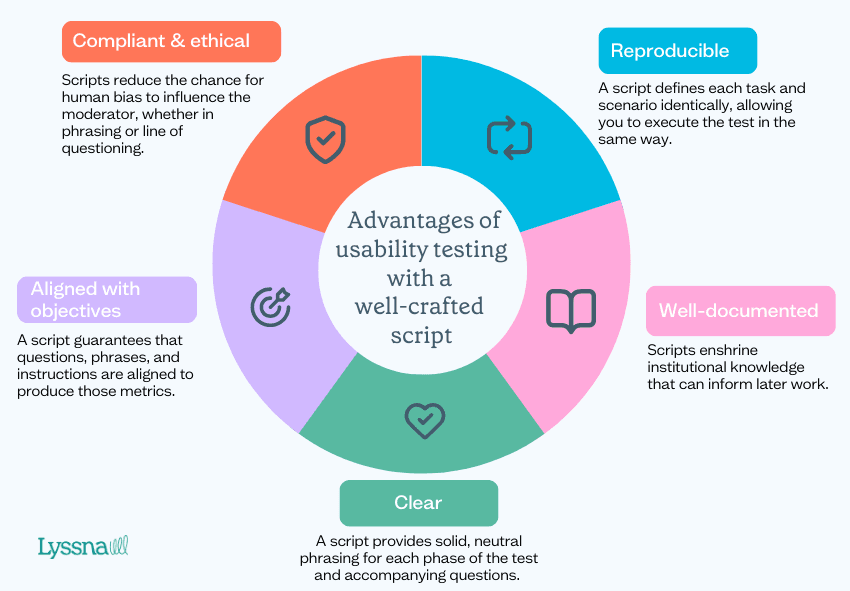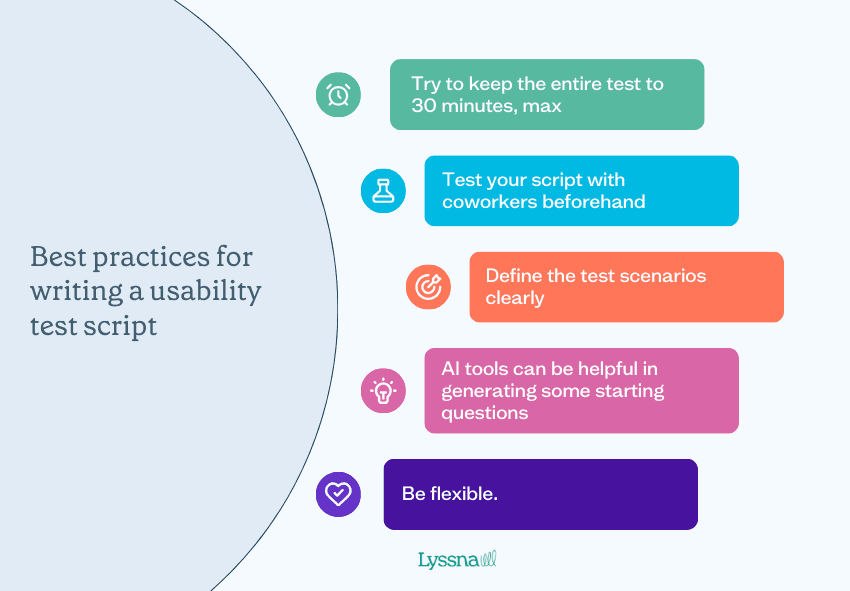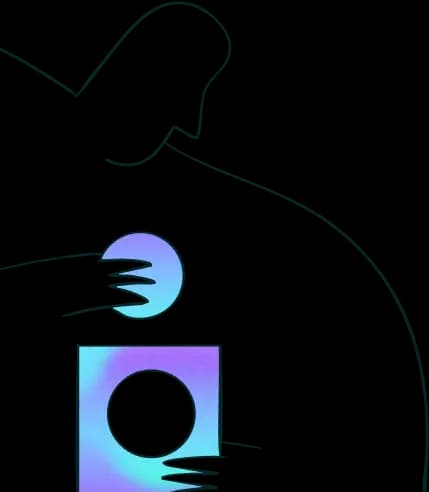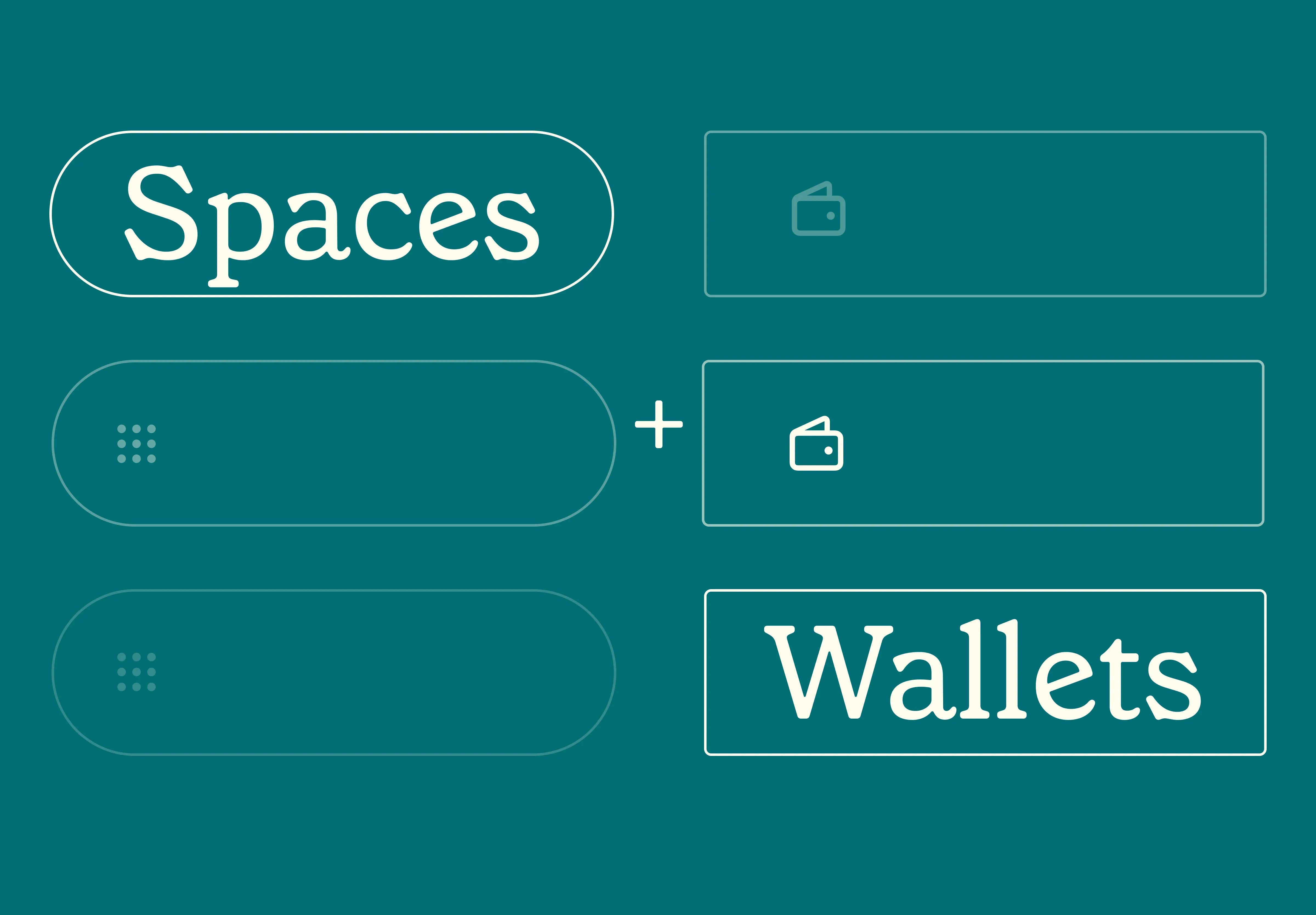14 Nov 2025
|13 min
Usability test script
Learn how to create effective usability test scripts that provide clear instructions, ensure consistency, and yield valuable insights for enhancing user experience.

They say you can lead a horse to water, but you can’t make it drink. The same is true for users: You can put them in front of a carefully designed product, but you can’t make them use it exactly how you intended.
That’s where usability testing can be helpful. Usability testing is a key moment in the user-centered design process in which real (or representative) users interact with a product or prototype and perform tasks outlined by a moderator.
The process can reveal insights into how people perceive information and interact with digital products. Maybe they have trouble navigating pages that you thought were intuitively laid out. Maybe they ask for an “undo” functionality that your team hadn’t even considered. Or maybe they blow right through the tests so quickly and seamlessly that the design team starts to wonder if more friction should be added.
However it plays out, you’ll want a script to guide these testing sessions, making sure that you give identical instructions to each user. After all, you don’t want to bring real users in to test a design only to introduce variables like differing directions or phrasings that could skew the results.
What is a usability test script?
A usability test script is an outline that guides everything a moderator says in a usability test, including introductions, test prompts, follow-up questions, and debrief questions.
Remember that usability testing differs from user testing. Usability testing looks to gauge key functionalities of a product or service – basically aiming to determine whether a user can complete key tasks. User testing, on the other hand, is much broader, evaluating not just the usability of the product but also how the user perceives it more holistically.

Creating a script before beginning a usability test makes sure that the test will be:
Reproducible: The script defines each task and scenario identically, allowing you (or even different testers) to execute the test in the same way. This helps for iterative testing, as well as comparisons over time.
Clear: Moderators can fumble for words occasionally, but a script provides solid, neutral phrasing for each phase of the test and its accompanying questions.
Well-documented: A well-defined script is invaluable documentation for iterative product development, enshrining institutional knowledge that can inform later work.
Aligned with objectives: If you’re testing for specific KPIs – like time on-page, completion rate, or even more qualitative metrics – a script guarantees that questions, phrasings, and instructions are aligned to produce those metrics.
Compliant and ethical: Scripts make sure that appropriate callouts are made in each session. They also reduce the chance for human bias to influence the moderator, whether in phrasing or line of questioning.
Elevate your research practice
Join over 320,000+ marketers, designers, researchers, and product leaders who use Lyssna to make data-driven decisions.
How to write a usability test script
Writing a usability test script involves preparing instructions and scenarios for participants to follow during the usability test. Scripts are most useful for moderated usability testing – that is, tests in which a human moderator provides prompts and instructions for the user. These tests could be run in person or remotely.
If you’re running an unmoderated test, you can still provide participants with clear instructions and guidance through written prompts or prompts integrated into the testing tool. These prompts can outline tasks, provide specific instructions, or be included as follow-up questions asking for feedback.
Introduction
Start by welcoming each participant and introducing yourself and anyone else from the team who’s present. You want the atmosphere to seem relaxed. Remember that people generally don't like being tested. It helps to assure them that you’re testing the product, not them, and that there are no wrong answers. (If this is an unmoderated test, you can similarly try to put the user at ease.)
Up front, you’ll also want to explain the purpose of the usability test as specifically as possible. If you plan to record the session for evaluation, you should ask for the user’s consent at this point before hitting record.
Look to establish a bit of rapport. While this is fairly easy for some people in less clinical contexts, it’s worth doing so rather intentionally here, so you can put the user at ease. Small talk about general shared vectors of interest – things like sports, the weather, or their call-in location – can be very useful here.
Lastly, this early phase is a good spot to ask some demographic questions, including age, occupation, and existing perception of the product or category. This data can be helpful for statistical evaluation but is also useful in getting the user comfortable with talking and delivering information in this context. Of course, avoid asking anything too personal, especially if it’s not statistically important or relevant to the test at hand.
Briefing the participant
You should have picked out 3–5 tasks for the user to perform during the test. See if you can sequence them logically; for example, they could 1) sign up for an account, 2) search for a specific type of product, 3) add it to the cart, and then 4) purchase it.
Clearly explain the specific task or scenario. Try to avoid using terms that are directly in the user interface, instead giving them scenarios. For example, instead of saying “pick out a laptop with a large screen,” you could say, “You’re looking for a new computer you can use to watch movies on when traveling for work.” This helps make sure that the user isn’t just looking for the words used on the menu but is thinking critically through a use case, the way real users would.
Lastly, encourage the user to speak aloud as they perform the task, narrating their actions and their thinking.
If you’re looking for guidance on how to create tasks and scenarios, the usability test plan chapter in our usability testing guide goes into more detail.
Questions to ask during each task
Allow the participant to start the task and observe their interactions, taking any relevant notes as you go. As the moderator, it’s okay to stay quiet during this part, allowing the user to think things through. If they pause for a long time, though, you could ask open-ended questions to understand their thought process, such as, “What are you thinking about?”.
After they complete the task, you can ask questions like:
"How easy or difficult was it to complete this task?"
"What aspects of the interface design helped or hindered you?"
"Did you encounter any unexpected or confusing elements?"
"What would you change to make this task easier?”
Wrap-up
Once the user has completed all of the tasks, give them an opportunity to ask questions or express any concerns they may have about the test or product. This open-ended qualitative feedback can provide additional insights that you or your team hadn’t anticipated regarding the design or overall user experience. If you're interested in learning more about how this kind of research fits into broader methodologies, explore different types of qualitative studies used in user research.
Debrief on what will happen next, any research incentives they’ll receive, and provide follow-up contact information if they have any questions or concerns.
Sample script
Let’s run through the above template with a test scenario. You’re a UX researcher working for a company that operates a popular travel booking app. A key area of focus for the company is improving the process of reserving a hotel through the app after booking a flight. The product team has made some updates to the app interface and you want to see how users navigate through the booking process. You’ll ask open-ended questions that give users multiple opportunities and ways to convey their experience.
Your script might read as follows:
Hi, and thanks for participating in this usability test. My name is [Your Name], and I'm a UX researcher at [Company Name]. Today, we’re looking to get your feedback on our travel booking app.
Our goal is to understand how users like you navigate our app, especially when booking hotels. Your feedback will help us make the app more user-friendly.
Remember that we’re testing the app, not testing you. There are no “right” or “wrong” answers.
This session will be recorded for research purposes only. Your responses will be kept confidential, and your personal information won't be shared.
To start, could you please tell us your name, age, and profession.
Have you used our app before, or is this your first time?
Can you tell me about your most recent travel experience or trip you're planning?
For today's task, imagine you're planning a weekend getaway for two people. Your task is to find and book a round-trip flight from San Francisco to New York on a weekend in November. Additionally, you'll need to book a hotel for your stay in New York.
Please use the app as you normally would. If you have any questions or encounter difficulties, feel free to ask. Remember to think out loud, sharing your impressions and any concerns as you navigate through the app.
Let's start with finding and booking a flight. Please start your search for a round-trip flight from San Francisco to New York on a weekend in November. Feel free to use any filters or options that you find necessary.
Now that you've completed the task, let's discuss your experience. How easy or difficult was it to find and book a flight from San Francisco to New York?
Were there any features or aspects of the app that you found particularly helpful during the flight booking process?
Did you encounter any challenges or confusing elements while booking the flight?
Now, let's proceed with the hotel booking. Based on your flight details, you'll need to book a hotel in New York. Please find a suitable hotel for your stay and book it.
Now that you’ve completed the second task, how was your experience finding and booking a hotel in New York?
Were there any specific features or pieces of information that you felt were missing or could be improved upon during the hotel booking process?
Thank you for sharing your thoughts. Could you tell us more about any specific issues or moments that stood out to you during these tasks?
Is there anything about the app's interface, layout, or options that you found particularly appealing or frustrating?
Did you feel confident that you could complete the tasks successfully?
Thanks for your time and feedback today. It will help us enhance the user experience of our travel app.
After this session, we’ll analyze the data and work on improving the app based on your feedback. We might reach out for follow-up questions if needed.
If you have any questions or further insights after the session, here's my contact information. You can reach out anytime.
Copy and adapt this usability test template to suit your needs. Bookmark this page so that you can come back to it the next time you’re planning a usability test.
Best practices for writing a usability test script
If you follow the template above, you should have a good, usable test script. However, a few best practices are worth reiterating:
Try to keep the entire test to 30 minutes, max. Much longer than that, and mental fatigue may skew the results.
Test your script with coworkers beforehand. Subtle phrasings may be worth reevaluating in case they’re not clear or bias users toward a particular pathway.
Define the test scenarios clearly, as in the usability test example above of a weekend getaway for two from San Francisco to New York.
AI tools can be helpful in generating some starting questions, but treat them as a first draft from a new hire. These tools don’t know your product or business objectives as well as you do, and they lack the human touch that can put users at ease.
Be flexible. A script should give you a steady framework to follow, but you can still leave room to ask follow-up questions about interesting insights or interpretations users proffer on their own.

Embracing usability testing: Enhancing user experience through insights
Usability testing plays a vital role in the user-centered design and product development process, allowing you to gain valuable insights into how users interact with digital products. By following a well-crafted usability test script, you can ensure consistency, reproducibility, and clarity throughout your testing process.
Usability testing not only helps identify areas of improvement but also validates design decisions and enhances the overall user experience. By prioritizing usability testing and incorporating user feedback, you can create products that truly resonate with your target audience, leading to increased user satisfaction and business success.
You may also like these articles


Try for free today
Join over 320,000+ marketers, designers, researchers, and product leaders who use Lyssna to make data-driven decisions.
No credit card required





